Sailing the wrong way is sometimes the right way.
For those of you who followed us as we sailed from Oahu to Ensenada, you may have wondered; ‘why did they sail this great loop around the pacific?’ We do admit that at no point in the first 1000nm did it look like we were aiming for Mexico, more likely Japan / Alaska. Don’t worry, we did eventually make it to Ensenada. Sailing long distances in the wrong direction is sometimes necessary to get us to our destination. We figured we owed you an explanation and tell you a little bit about what we found when we hit the North Pacific Gyre.
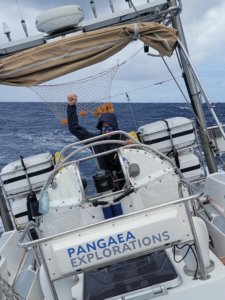
We departed Hawaii which is directly downwind of Ensenada in a band of ENE trade winds. If we aimed directly for Ensenada, this would meant zig-zagging (tacking) most of the way upwind, crashing into waves and an living on an uncomfortable heel. So therefore we planned a route that would limit this to a 5 day upwind zig (single tack) north to get out of these winds and into the center of the high pressure system (the North Pacific Gyre). Then finding favorable winds to head east on a more comfortable downwind sail (which we enjoyed way more than the ‘zig’ north) and eventually headed south east around 600nm off the coast of America. Bruce best described living onboard during the first few days upwind sail “like a crazy house of fun but with no mirrors”. 18 days of that would be exhausting!
The other advantage of going this way was the Gyre. This remote part of the ocean is usually dictated by the weather, the regularity of the clockwise rotation of the North Pacific high and other factors create a vortex of currents. As a result, there is a significant accumulation of plastic in the centre. By sailing into the centre of the gyre, we were able to utilise Seadragon’s onboard science equipment to trawl for micro plastics on the surface of the ocean and analyse the findings.
The great pacific garbage patch is it’s more famous name, it’s isn’t actually a floating island of rubbish, it’s more like a soup, where the plastic is constantly breaking down into smaller and smaller fragments. For nearly 2 weeks we saw large items such as buckets, crates, bottles, floats and ropes. We also saw a huge amounts of fragments visible to the eye as we sailed by at 7 knots. When we got into the centre of the high we deployed the Manta Trawl. This takes samples by collecting micro plastics in a small net; 60cm x 15cm, as it skims along the oceans surface, towed by Seadragon for approximately 1nm. Our biggest trawl collected a sample of 386 peices of micro plastics, all invisible to the eye from the deck of the boat. We also picked up lots of organic matter such as phytoplankton, man of war jellyfish, crabs and other mysterious jelly like substances like Salps. Seeing the plastic mixed in with all this life is shocking and explains why this wilderness is struggling to stay healthy.

The albatross that followed us for a few days and other sea creatures that live in the oceans, rely on this microscopic life for food, and easily mistake the colourful plastic for food. Jayden kept her family of crabs, otherwise known as ‘the crabbingtons’ for a little while before returning them to the seas.
The final advantage of the centre of the gyre is there is no wind. As well as perfect trawling conditions, it is the perfect excuse for a quick dip in the middle of the ocean. We decided to go for 2 swims in the same day to take advantage of it. It was also Ben’s reward for his heroic drone catching skills, a 3000 fathom deep swim. This also allowed the crew to take a break and rest after the upwind sail and get there sea legs for the final run to Ensenada.
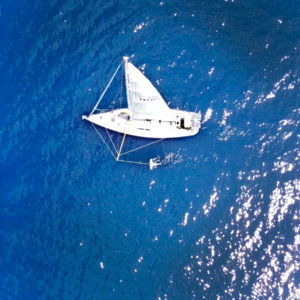
We then turned East and were blessed with good NW Winds that took us at speeds of 8-11 knots downwind towards Mexico. Followed by a few days of calm in which Ben and Elle caught a lovely Yellow Fin Tuna, and of course another swim! In the name of science, we also took a look at the Tunas stomach contents and found micro plastics in its poo. Sushi was then served and a few days of delicious creative tuna meals enjoyed by all…(except Bruce 😉 ).
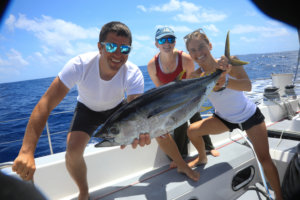
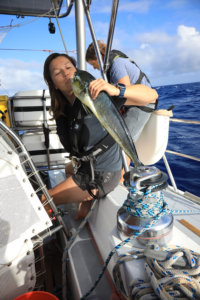
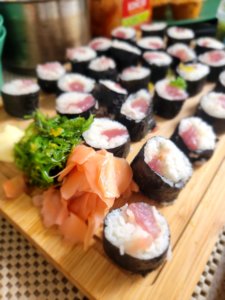
Lastly, we had a little reaching blast where the high pressure system squeezes against the contours of America, followed by our first sightings of Dolphins (finally) and Fin whales on the last day approaching Ensenada.
So all in all, Neptune and the wind gods blessed us with perfect conditions for sailing the non direct route to Ensenada and what a trip it was!
Photos by Andrew Newman @whereisnewmo


















